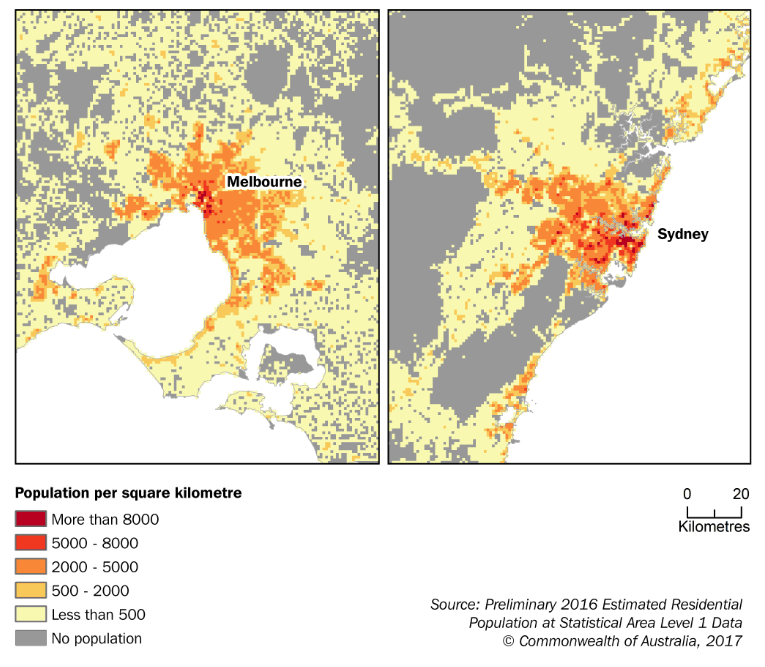|
AUSTRALIAN POPULATION GRID 2016 |
This release presents preliminary estimated residential population (ERP) for 2016, represented as 1 km
2 grid cells across Australia. This grid resolution offers a measure of population density and depicts the distribution of population across the Australian landmass. The population value represented in the grid cells has been modelled from the preliminary 2016 population estimates for Statistical Area Level 1 regions in the 2011 Australian Statistical Geography Standard (ASGS). Figure 1 is a population density map using the 1 km
2 grid.
Figure 1. Estimated Residential Population Density Grid, June 2016
Australia's most densely populated area in 2016 was in Sydney around Haymarket and Ultimo. The 1 km
2 grid cell covering these localities had an estimated residential population of 18,130.
| Figure 2 compares the population grid for Sydney and Melbourne. It shows that Sydney had more areas in the highest density range shown in the map with 38 km2 exceeding 8,000 people per square kilometre compared to Melbourne which only had 12 km2 exceeding 8,000 people per square kilometre. Sydney also had larger and more widely spread areas of the second highest density class with 131 km2 of between 5,000 and 8,000 people per square kilometre, while Melbourne had 49 km2 in the same range. Brisbane was the only other capital city to register in these higher density categories with 6 km2 between 5,000 and 8,000 people per square kilometre. |
Figure 2. Estimated Residential Population Density Grid around Melbourne and Sydney, June 2016

Table 1 shows the area within each Greater Capital City Statistical Area (GCCSA) under 6 population density classes, from no population to very high. These areas are calculated from the Population Grid and the classes are based on the ranges used in Figures 1 and 2. The Brisbane GCCSA had the largest area of very low population density (less than 500 people per square kilometre) at 9,584 km˛ in 2016. This highlights the spread of low density population around Brisbane and also the relatively large extent of the Brisbane GCCSA when compared with other capital cities.
Table 1: Total area in six population density classes in Greater Capital City Statistical Areas (km˛).
|
 | No population | Very low | Low | Medium | High | Very High |
 | (0)* | (Less than 500)* | (500-2000)* | (2000-5000)* | (5000-8000)* | (More than 8000)* |
|
| Sydney | 6658 | 3952 | 759 | 826 | 131 | 38 |
| Melbourne | 2709 | 5337 | 930 | 965 | 49 | 12 |
| Brisbane | 5111 | 9584 | 726 | 411 | 6 | 0 |
| Adelaide | 195 | 2372 | 409 | 275 | 0 | 0 |
| Perth | 2509 | 2846 | 644 | 417 | 0 | 0 |
| Hobart | 501 | 1071 | 106 | 17 | 0 | 0 |
| Darwin | 2127 | 982 | 43 | 21 | 0 | 0 |
| Canberra | 1807 | 303 | 204 | 46 | 0 | 0 |
|
| * people per square kilometre |
| These population density classes have been used for analysis purposes only and are not an ABS standard classification |
Of the Greater Capital City Statistical Areas, Sydney and Melbourne had the highest densities, both exceeding 17,000 people per square kilometre in the most densely populated areas. Brisbane had the next highest density at 7,470 people per square kilometre, while Perth, Adelaide, Canberra, Darwin and Hobart all had maximum population densities less than 5,000 people per square kilometre. Hobart had the lowest maximum population density of Australia's capital cities (3,160 people per square kilometre).
Please Note: This publication can be viewed in three formats:
- ESRI Grid format - for use in Geographic Information Systems (GIS) only.
- GeoTIFF format - for use in a Geographic Information System (GIS) and in some graphics software.
- PNG format - for use in any graphics software including those bundled with major operating systems (Microsoft Windows, Apple OS X & iOS).
Some of the advantages the grid format provides are:
- it enables accurate comparison with other countries using grid based measures of population and population density;
- it offers greater spatial accuracy in rural regions where traditional geographies are very large; and
- it enables accurate and efficient integration of population data with other data traditionally produced in grid format such as environmental datasets.
The grid files in GeoTIFF format and ESRI Grid format are for use in a Geographic Information System (GIS) and are located in the 'Downloads' tab of this publication. These GIS files are aligned to the National Nested Grid (NNG) standard for Australia.
The PNG file is also available in the 'Downloads' tab of this publication. |
 Quality Declaration
Quality Declaration  Print Page
Print Page
 Print All
Print All